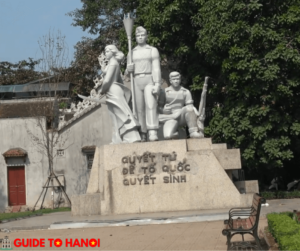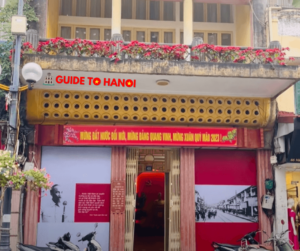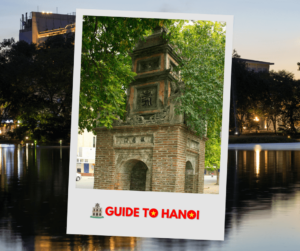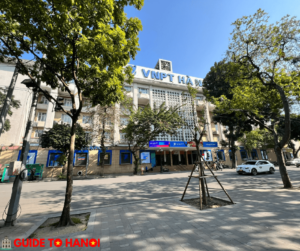Ho Chi Minh Mausoleum
Behold the Ho Chi Minh Mausoleum, a colossal granite behemoth looming over Hanoi’s Ba Dinh Square!
Welcome to the heart of Hanoi, where history stands still in the majestic presence of the Ho Chi Minh Mausoleum.
This iconic structure pays tribute to the founding father of modern Vietnam, Ho Chi Minh.
Now, imagine this: Ho Chi Minh’s grand plan was to go out with a bang. His will called for a cremation, with his ashes scattered across Vietnam.
But, plot twist! The Vietnamese government opted for a Soviet-style spectacle, embalming him instead. Construction only kicked off in 1973, a few years after Ho’s 1969 exit.
Ho rests in a concrete-and-granite fortress, inaugurated on August 29, 1975, with a view that probably wasn’t on his wishlist.
Prepare to journey through time as we explore this monumental site’s rich history and significance.
The Architectural Marvel
Prepare to be awestruck by the grandeur of the Ho Chi Minh Mausoleum’s architecture.
This monumental structure, inspired by Lenin’s Mausoleum in Moscow, blends Soviet design and traditional Vietnamese elements.
The imposing gray granite structure is a testament to the nation’s gratitude for its revolutionary leader.
The Mausoleum is located at Ba Dinh Square – the sacred ground where President Ho dropped the independence bomb on Vietnam back in 1945.
This square is like a patchwork quilt made of 240 grassy patches, separated by concrete catwalks that practically beg for a catwalk.
But hold your horses! Walking on the grass is a big no-no, folks. It’s like the VIP area of VIP areas, so keep those eager feet on the straight and narrow—or the intersecting concrete pathways, to be precise.
Ho Chi Minh’s Final Resting Place
Discover the solemnity of Ho Chi Minh’s final resting place.
The Mausoleum houses the embalmed body of the beloved leader, allowing visitors a unique opportunity to pay their respects.
Following his death in 1969, against his wish for cremation, the Vietnamese government opted for a Soviet-style embalming process.
His body is displayed in a glass case, and visitors can pay their respects as they pass through the Mausoleum.
Preserving Ho Chi Minh’s body symbolizes reverence and is significant to the nation’s historical legacy.
The Changing of the Guard
Experience the precision and pageantry of the Changing of the Guard ceremony, a ritual at the Mausoleum in the mid-morning.
The guards, dressed in white uniforms, execute precise and synchronized movements, adding a touch of grandeur to your visit.
Be sure to check the schedule for this captivating display.
Dress Code Decoded
Before you make your way to the Mausoleum, take note of the dress code.
Visitors were asked to dress modestly as a mark of respect to the revered leader.
Sleeveless tops, shorts, and hats are not permitted.
Embrace the cultural norms and dress the part for a seamless visit.
Timing is Everything
Plan your visit strategically, as the Mausoleum has specific opening hours.
Arriving early at the Mausoleum is recommended, as the lines can get very long.
| Period | Days | Opening Hours |
|---|---|---|
| April – September | Tue – Thu | 7:30 am – 10:30 am |
| Saturday-Sunday | 7:30 am – 11:00 am | |
| December – March | Tue – Thu | 8:00 am – 11:00 am |
| Saturday-Sunday | 8:00 am – 11:30 am |
Note: The mausoleum is closed on Fridays.
But wait, there’s more!
In the fall (October and November), the embalmed VIP is jet-setting to Russia for “some spa treatment.”
So, during that time, the Mausoleum takes a siesta for two months.
It’s all preventive maintenance and restoration – even embalmed legends need a touch-up now and then!
Surrounding Splendors
Extend your visit to explore the surrounding attractions.
The Ho Chi Minh Complex includes the One Pillar Pagoda, Ho Chi Minh’s stilt house, the Presidential Palace, and the Ho Chi Minh Museum.
Immerse yourself in the history and culture of Vietnam by delving into these nearby treasures.
Wrapping Up the Experience
As you bid farewell to the Ho Chi Minh Mausoleum, take a moment to reflect on the significance of this historical landmark.
Whether you’re a history enthusiast or a casual tourist, the Mausoleum offers a profound glimpse into Vietnam’s Mausoleum, the enduring legacy of Ho Chi Minh.
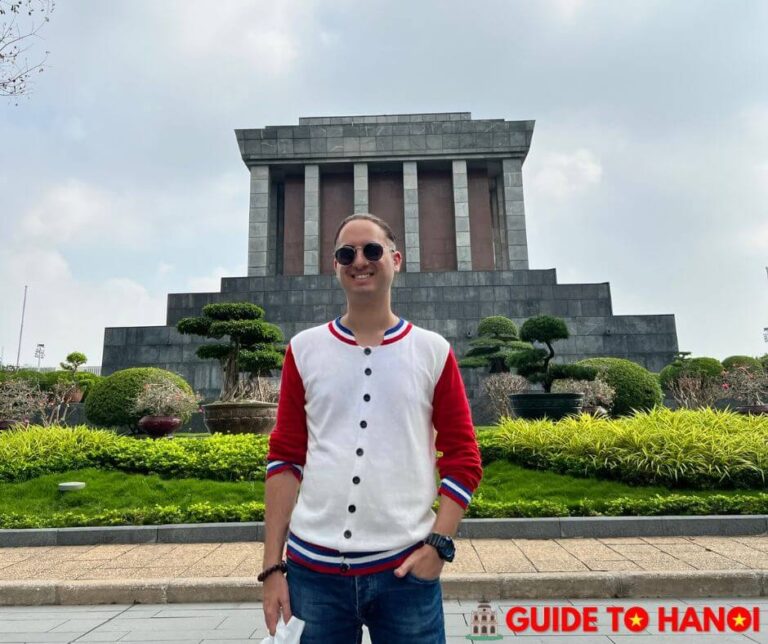
| Do’s | Don’ts |
|---|---|
| Maintain Respectful Vibes | No Chit-Chat, Smiles, or Swagger: Saunter with purpose into the darkened inner sanctum; guards have a radar for attitude slips. |
| Embrace the Early Bird Status | Fashion Police Alert: Don’t risk arriving late; the mausoleum opens at 8 am, but the savvy show up at 7 am to dodge the crowd. |
| Camera Snapping? Think Again. | Say Cheese? Not Here: Guards snatch up cameras like candy, but don’t worry; you’ll get your gear back on the way out. |
| Cover Up, Fashionistas! | No Shorts, Singlets, or Sleeveless Chic: Dress to impress this holy ground; even in tropical heat, keep it classy. |
How to get to the Ho Chi Minh Mausoleum?
You can’t miss the Ho Chi Minh Mausoleum if you are coming to Ba Dinh Square because it’s right in the square’s center – but it’s a bit tricky to find the entrance to the place – and trust me, I’m talking from my experience because I tried to get there by walking.
I recommend you take a taxi because the drivers know where the entrance is.
But if you prefer to walk, here’s a link to the entrance on Google Maps.
You can see it here, too:
Thank me later – I wish I had that entrance location on the map when I searched it!
Who is Ho Chi Minh?
Ho Chi Minh, born Nguyen Sinh Cung on May 19, 1890, and later adopting the name Ho Chi Minh (“He Who Enlightens”), was a crucial figure in the struggle for Vietnamese independence and the founding father of the Democratic Republic of Vietnam, which eventually became the Socialist Republic of Vietnam.
Ho Chi Minh played a central role in the anti-colonial and anti-imperialist movements of the 20th century.
He was influenced by nationalist and socialist ideologies, drawing inspiration from the Russian Revolution and the principles of Marxism-Leninism.
Ho Chi Minh led the Viet Minh, a communist-led resistance movement against French colonial rule during the First Indochina War.
After the defeat of the French at the Battle of Dien Bien Phu in 1954, Vietnam was divided into North and South Vietnam. Ho Chi Minh became the leader of North Vietnam, and he continued to advocate for the reunification of the country under a communist government.
The Vietnam War (1955-1975) ensued, with Ho Chi Minh serving as a symbol of resistance against the United States and its allies in the South.
Ho Chi Minh passed away on September 2, 1969, just before the reunification of North and South Vietnam in 1975.
Despite his death, his legacy as a revolutionary leader who fought for the country’s independence and unity endures in Vietnamese history.
The Ho Chi Minh Mausoleum in Hanoi is a tribute to his contributions, and his image is featured in Vietnam’s currency and various monuments throughout the country.
When to Visit the Ho Chi Minh Mausoleum?
If you’re planning to pay your respects to Ho Chi Minh in the splendid setting of his mausoleum, timing is everything.
Here’s the lowdown on when to make your move:
April – September:
- Days:
- Tuesday to Thursday: 7:30 am – 10:30 am
- Saturday-Sunday: 7:30 am – 11:00 am
December – March:
- Days:
- Tuesday to Thursday: 8:00 am – 11:00 am
- Saturday-Sunday: 8:00 am – 11:30 am
Please notice the mausoleum is not open on Fridays.
Pro Tips:
- Early Bird Advantage: Beat the crowd by arriving at 7 am, especially if you’re keen on that first-in-line glory.
- No Fashion Faux Pas: Remember, it’s a holy site—cover up those shorts and sleeveless shirts for an appropriately reverent look.
- If you visit during the fall (October and November), ensure the place is not closing.
Plan wisely, and your visit to the Ho Chi Minh Mausoleum will be a timely success!
Pro Tips for Your Ho Chi Minh Mausoleum Visit
Early Bird Advantage:
Arrive early to beat the crowd and secure a spot for a smoother, more contemplative experience.
Stand on the left side of the queue:
So you will ensure you stand closer to Ho Chi Minh!
Respectful Attire:
Adhere to the dress code.
Dress modestly to show respect for the solemnity of the site, avoiding shorts, sleeveless shirts, and hats.
Silence is Golden:
Maintain a serene demeanor while inside the mausoleum.
It’s a space for reflection, so keep conversations to a minimum.
Camera Savvy:
Leave your camera behind, or be prepared to surrender it.
Photography is prohibited inside the mausoleum, so soak in the experience without the distraction of lens clicks.
Explore the Complex:
Extend your visit to explore the nearby attractions within the Ho Chi Minh Complex, such as the One Pillar Pagoda and the Ho Chi Minh Museum.
Check Maintenance Schedule:
Plan your visit around the maintenance schedule. The mausoleum periodically closes for maintenance, so verify the dates to avoid disappointment.
Cultural Sensitivity:
Remember, you are in a place of historical and cultural significance.
Be mindful of local customs and traditions, enhancing the overall quality of your visit.
Queue Intelligence:
If queue length concerns you, plan your visit during weekdays or slightly off-peak times to minimize wait times.
Learn the History:
Brush up on Ho Chi Minh’s history before your visit. A little background knowledge will enhance your appreciation of the mausoleum’s significance.
Reflect and Revere:
Take a moment to reflect on the historical importance of the site.
Whether a history enthusiast or a casual tourist, the Ho Chi Minh Mausoleum offers a unique and thought-provoking experience.
Can I visit Ho Chi Minh Mausoleum?
Yes, the Ho Chi Minh Mausoleum is open to visitors.
Please check the schedule in this page, as it is periodically closed for maintenance.
Can you see the body of Ho Chi Minh in the mausoleum?
Indeed, you can view the embalmed body of Ho Chi Minh inside the mausoleum.
The experience is a unique opportunity to pay respects to the revered leader.
How much does it cost to enter Ho Chi Minh Mausoleum?
Entrance to the Ho Chi Minh Mausoleum is typically free of charge.
Are visitors not allowed to take pictures inside Ho Chi Minh Mausoleum?
Correct, photography is strictly prohibited inside the mausoleum.
Guards collect cameras before entry, and visitors can retrieve them afterward.
The visit inside to see Ho’s body is so short that it is better to cherish the moment than be busy with phones and cameras.
Is it worth visiting Ho Chi Minh Mausoleum?
Absolutely! The mausoleum holds historical significance, offering a profound glimpse into Vietnam’s past and the legacy of Ho Chi Minh.
Is there a dress code for Ho Chi Minh Mausoleum?
Yes, there is a dress code. Visitors are expected to dress modestly, avoiding shorts, sleeveless shirts, and hats as a mark of respect.
What can people see in the mausoleum?
Besides Ho Chi Minh’s embalmed body, visitors can explore the Ho Chi Minh Complex, including the One Pillar Pagoda and the Ho Chi Minh Museum.
Can men wear shorts to Ho Chi Minh Mausoleum?
No, shorts are not permitted.
Visitors are advised to dress modestly, covering legs and shoulders, to show respect for the cultural and historical significance of the site.
How long is the queue for Ho Chi Minh Mausoleum?
Come early! The queue length can vary, so arriving early is advisable to avoid crowds.
The mausoleum opens in the morning, and being there early can help streamline your visit.
What is special about Ho Chi Minh Mausoleum?
The mausoleum is a symbol of Vietnam’s history, housing the embalmed body of Ho Chi Minh.
It is a testament to the nation’s gratitude for its revolutionary leader.
Address:
- 8 Hung Vuong, Dien Bien, Ba Dinh, Hanoi
Opening Hours:
- April - September:
Tuesday to Thursday:
7:30 am - 10:30 am
Saturday-Sunday:
7:30 am - 11:00 am - December - March
Tuesday to Thursday:
8:00 am - 11:00 am
Saturday-Sunday:
8:00 am - 11:30 am
Entrance Fee:
- Free

